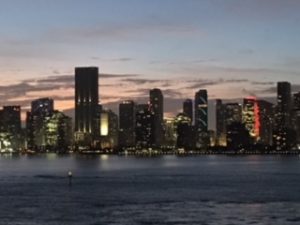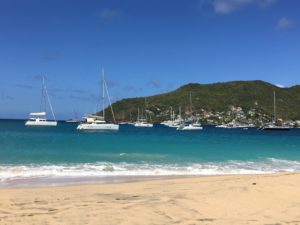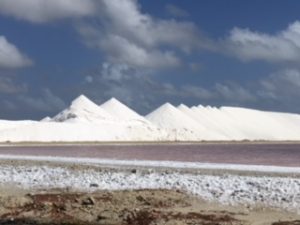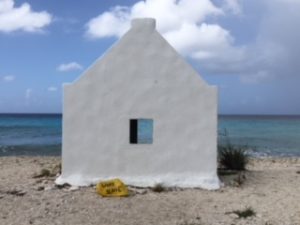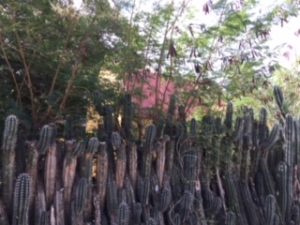Happy Valentine’s  Day to all my friends!
Day to all my friends!
Well, it certainly has been quite a while since I have been in touch. We had a lovely cruise and this time we both stayed healthy thank goodness. It was not until two days afterwards that Mike broke out in coughs and sneezes, probably got the virus on the plane home from Miami, and on Saturday I started. Despite our early flu shots we both got the flu and are staying put with lots of medications. The weather is cooperating, dark clouds and periods of misty rain make it cozy to stay inside.
We left Miami on January 23 in the late afternoon/early evening, capturing a view of the Miami skyline:
After two days on the Caribbean Sea we visited first the Island of Aruba, then Bonaire, both still with strong ties to the Netherlands. Aruba and Bonaire, currently self governing island nations, used to be part of the Dutch West Indies and both produce their own supply of water from seawater. They also produce literally mountains of salt for export to Europe, Asia and America.
Bonaire is famous for snorkeling and especially diving, all around the island. I do not dive, because you need training and a license for that, and there is enough to see with just snorkeling along a reef, I always thought, but I was not aware of “snuba diving”. And now that I am, I have put a new item on my bucket list!
Snuba diving is a relatively young form of diving that was invented in 1989 and further patented in 1990. Since its inception, it has become popular in a large range of locations throughout the world, such as the Caribbean and Hawaii. So what exactly is Snuba diving? In essence, snuba diving is a combination or snorkeling and SCUBA diving. Snuba diving, like snorkeling, doesn’t require carrying an air tank in order to breathe while swimming underwater. Instead, the air tank is connected to a small raft that sits atop the water above you. Snuba divers are connected to the raft via a lengthy hose. This hose allows divers to dive down approximately 15 ft. and stay there for an extended period of time, swimming around freely without the need to come up to the surface for air, which is one of the primary disadvantages of snorkeling. Whoa! Does that not sound fantastic? There was one other island on our cruise that offered the option of a Snuba diving expedition, but when I wanted to sign up for that on the ship, they said it was canceled because of lack of participation. Had I only know sooner!
In the sixteen hundreds slave trade was rampant in these islands. Tiny living quarters for the slaves were constructed out of stone, rising no higher than a man’s waist with a small entrance to crawl into. Some of these tiny dwellings, in which a man sadly can not stand upright, provided sleeping quarters for up to six people. There must also have been white slaves, since the yellow rock in front of one of the slave quarters indicates “white slave”. In my picture you see the window. On the other side, facing the ocean, is a narrow door opening, the top of which came to my waist.
On both Aruba and Bonaire, Organ Pipe cactus grows everywhere. And of course through the ages people have made use of the things at hand: we saw cactus fences in many places. Now those are fences no burglar will climb!
On Grenada I took a catamaran tour to a snorkeling place and “the most beautiful beach in the world”. Well, the snorkeling place was just from the beach to a rock wall, and the most beautiful beach in the world can’t compare to the beaches in Hawai’i, where I had the privilege to live for twelve years.
One thing is certain though, the Caribbean as well as the Hawaiian waters are warm, turquoise and blue, oh, so blue!
It’s a Wonderful Life!
Until next time!
Ronny

